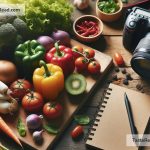Creating a Story with Your Food Photography: The Power of Composition
In the vibrant world of food photography, a picture can indeed be worth a thousand words. But have you ever considered what makes some food photographs stand out more than others? Beyond just capturing a dish’s visual appeal, the true magic lies in creating a story. This is where the power of composition plays a crucial role.
Composition in photography is how you arrange elements within your frame. It’s like putting together pieces of a puzzle in such a way that they tell a compelling story. With thoughtful composition, you can evoke emotions, tell a story, and even transport the viewer to a different place or time, all through images of food. Let’s explore how you can harness this power in your food photography.
Start with a Clear Concept
Before you even pick up your camera, think about the story you want to tell. Are you shooting a steamy bowl of soup that evokes a sense of warmth and comfort on a rainy day? Or are you capturing the vibrant colors of a summer salad that screams freshness? Your concept will guide your composition, from the props you choose to the angle and lighting.
Use Props to Set the Scene
Props can be powerful storytelling tools in food photography. A rustic wooden table, vintage silverware, or an elegantly draped linen can set the mood and add depth to your story. However, the key is to not let the props overpower the main subject – your food. Use them thoughtfully to complement the dish and contribute to the narrative you’re aiming to create.
Play with Angles
The angle from which you shoot can dramatically alter the story you’re telling. Top-down (or bird’s eye view) shots are great for showcasing the layout of a dish and are perfect for complex arrangements or when you want to emphasize composition. Side-angle shots, on the other hand, can give a sense of depth and are ideal for highlighting textures and layers, like the crust on a perfectly baked cake or the layers of a stacked sandwich. Experiment with different angles to find the one that best tells your story.
The Rule of Thirds: Your Secret Weapon
One of the simplest yet most effective composition techniques is the rule of thirds. Imagine dividing your frame into nine equal segments by drawing two equally spaced horizontal lines and two equally spaced vertical lines. Placing your main subject along one of these lines or at the points where they intersect can create a more balanced, visually pleasing shot. This technique can help guide the viewer’s eye to the focal point of your photo, making the story you’re trying to tell clearer.
Play with Light and Shadow
Lighting can make or break your food photography. Natural light is usually the best choice, as it can beautifully highlight the textures and colors of your food. Playing with shadows can add drama and mood, while soft, diffused light can create a more tender, inviting atmosphere. Think about what kind of story you want to tell and use light and shadow to set the tone.
Capture the Action
Sometimes, what makes a food story captivating is showing it in action. A sprinkle of powdered sugar in mid-air, a drizzle of honey just before it hits the pancake, or the steam rising from a hot dish can bring your photo to life. These action shots can make viewers feel like they’re right there, about to dive into the dish.
Focus on the Details
Don’t forget the power of close-ups to tell a story. Highlighting the crisp edges of a freshly cut fruit or the gooeyness of a chocolate chip cookie can evoke tactile sensations, making your viewers almost taste the food through the picture. These details can be the finishing touches that complete your food story.
Conclusion
Crafting a story with your food photography takes more than just snapping pictures of delicious-looking dishes. By mastering the art of composition, you can transform your food photos from simple snapshots to captivating narratives. Remember, the goal is to make your viewers feel something – whether it’s nostalgia, hunger, or curiosity. So, the next time you’re photographing food, think beyond the plate and consider the story you want to tell. Grab your camera, and let’s make some mouthwatering masterpieces!


